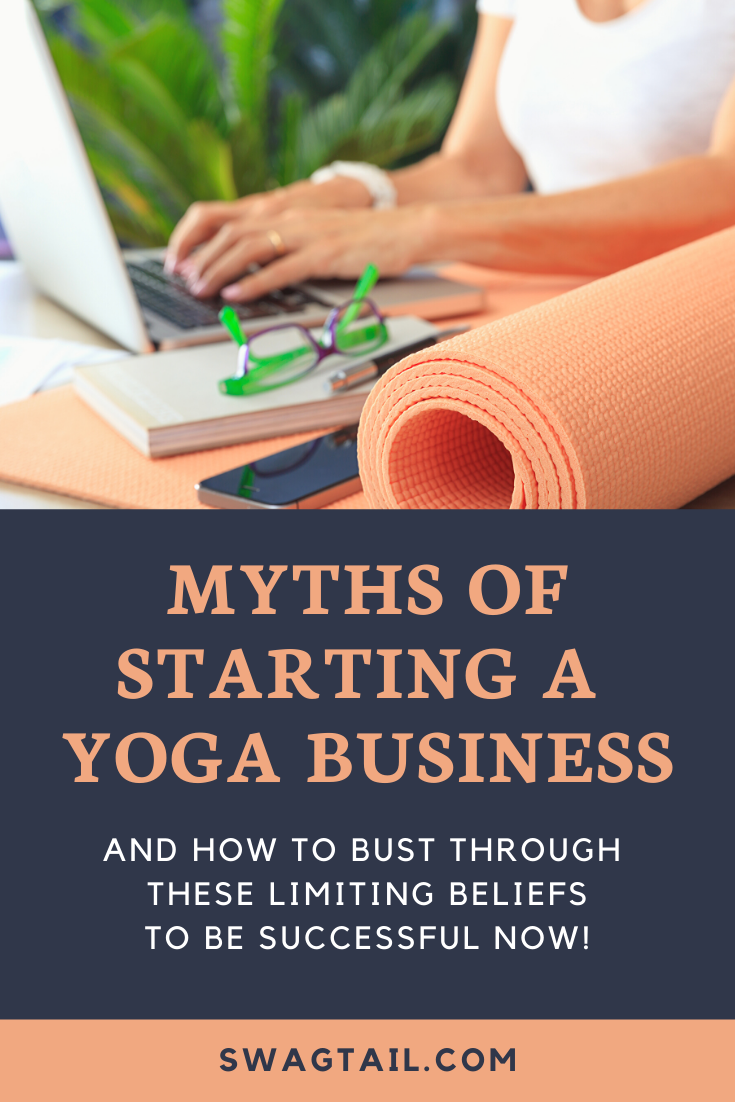 Starting a yoga business can seem daunting or downright debilitating. This is because the term ‘business’ is often misunderstood. Plus, when you search online for ways to begin, you find numerous articles about opening a yoga studio (which is really only one way to thrive in the growing yoga industry. This article uncovers common myths about starting a yoga business, and how you can flip your inner script to confidently take action today.
Starting a yoga business can seem daunting or downright debilitating. This is because the term ‘business’ is often misunderstood. Plus, when you search online for ways to begin, you find numerous articles about opening a yoga studio (which is really only one way to thrive in the growing yoga industry. This article uncovers common myths about starting a yoga business, and how you can flip your inner script to confidently take action today.
This topic can get very big quickly….
Kind of like the conversation that starts with an old friend and ends up lasting well over an hour (although it only felt like minutes).
With that in mind, we’re just going to look at the tip of the iceberg today. I’m just going to scratch the surface with these ideas. As I look back over the various phases of my yoga career, I can see where many of these myths held me back.
For example, for years I worked as an employee of a CSU, Chico–teaching yoga and lecturing in the Kinesiology department. Yet I was so comfortable in that position that I did little else to build my name in the community. Basically, I didn’t put a longer-term business plan in place.
Thus, when I decided to leave the university, I found I was completely starting over. My hope is that by getting a glimpse of these myths now–and utilizing the many articles and online courses here at Swagtail–you sidestep many of the heart-breaking and time-sucking mistakes I made myself.
Photo Credit: Rawf8
WHAT IS A YOGA BUSINESS?
To understand what a yoga business is, it’s helpful to first understand the broad definition of business in general. Business involves an organization where goods and services are exchanged for one another. It’s also described as:
- A person’s regular occupation, profession, or trade,
- A particular field of endeavor, or
- Any serious activity requiring time and effort (and the avoidance of distractions)
Before money entered the equation, people used the barter system to trade things of value (like milk in exchange for grains or bread). Today you’ll most likely get paid in cash or digital currency for teaching yoga.
In either case, the yoga business you operate will enhance your livelihood. This can take shape as a portion of your income stream, or as all of it. This simply depends on how you organize your business now. And, it can change depending on how you want to scale it in the future.
A Quick Side Note
It’s common to still see aspects of the barter system in the yoga industry today. For example, Bella Prana yoga has a team of desk angels that help with a wide array of tasks in the studio. Their time and energy is exchanged for the opportunity to access unlimited yoga classes.
Or, if you’re just starting a yoga business and have a smaller budget, you can trade your teaching services with those who excel at website design, graphic design, writing copy, or photography. The options are endless and this can be a really great way to get into the marketplace without incurring debt as you begin.

Photo Credit: Bella Prana Yoga
WHAT IS A MYTH?
Before we dive into the myths of starting a yoga business, I figure it’s best to also provide a working definition for the word ‘myth.’ A myth is a widely held, but false belief or idea.
Now beliefs are just thoughts that get set on repeat. They’re the ideas that you learned from your environment–your parents, family members, friends, and cultural surroundings–and they are the mental schema that are continually refined through your life experience.
Beliefs are great because they help you understand the world around you. This is super important because beliefs inform your body how to respond in any given situation. And when these beliefs align with your goals and dreams, they can be a powerful catalyst to move forward (like when you’re starting a yoga business).
Yet, when a myth–or false idea–permeates the mind, your aspirations might be thwarted. This can keep you stuck in the same place or limit your own potential for success. A perpetuated myth can also cause you to undervalue your experience. Or, it can prevent you from starting a yoga business at all.
So let’s unpack some common myths in the industry today. You can then see which ones might be holding you back (and you can use the tips in this post to blow past any outdated ideas and embrace success today).

Photo Credit: Ember and Earth Photography
MYTH 1: A YOGA BUSINESS = OPENING A STUDIO
This is the first myth I want to address because it’s perhaps the most prevalent. Yes, it’s true that opening a yoga studio can be a gratifying way to support your community, work with an amazing team of teachers, and share your passion for yoga. Click here for more articles if this is your area of interest.
Yet that’s only one version of how your yoga business can come to life. Remember, a yoga business is simply the organizational structure behind how you teach yoga. If you recently graduated from a 200-hour teacher training program (or you have in the past and are now ready to cash in on your investment), then here are two really common ways your yoga business will take shape:
Get Hired as an Employee
One way to get paid to teach yoga is to get hired on as an employee. This could be at a yoga studio, health club, wellness center, sports complex, sports team, senior citizen center, or any other wide array of options today where companies want to enhance their value by offering yoga.
Being an employee has many benefits, some of which include:
- Reduced upfront costs of starting a yoga business
- Less overall risk at the beginning of a career
- [Potential] Paid sick leave, vacation time, and health benefits
- Access to a large client base
- Provision of the necessary props and other teaching equipment you might want to make your job that much easier.
The downside of this is that you might have less flexibility over when and how you teach. Also keep in mind that any clients you meet at these locations are likely property of the company for whom you work. This means that if you want to work privately with any clients you meet on site, a finders fee, or percentage of your pay, might go to that company. Just make sure to read the fine print before signing a yoga contract so you don’t cross any boundaries.
Be Self-Employed
When you are self-employed, you work for yourself. This is common when you teach yoga as an independent contractor. It’s also the case when you own a studio. But to keep things simple, I want to focus this section on those of you not taking the studio ownership route at this point in time.
When you’re self-employed, you are contracted by others to provide a service (aka teach yoga). This can be to work in a one-on-one setting or work with groups. Yet, because you’re not an employee, you get to decide the methodology you use to teach. You get to set your own schedule as well as determine the great locations at which to offer your services. Plus, the income-earning potential on this route can often far exceed that of being an employee.
Keep in mind. that as a yoga freelancer, there are specific logistical elements to line up when starting your yoga business. Our Launch your Yoga Business Course takes an in-depth look at this. You can also email me if you have questions about this, too.

Photo Credit: Davit85
MYTH 2: A YOGA BUSINESS MUST BE A FULL-TIME GIG
Many new yoga teachers are hesitant to start a yoga business because they want to establish a solid foundation of teaching skills first. I totally get this because I know you want to offer the highest quality yoga experience for your students. Plus you want to meet their needs in a safe and uplifting way.
Hear me on this, though.
Your yoga business is simply the platform from which you share your love of yoga (and it’s incredible capacity to transform lives).
And building a yoga platform is all about relationships. As you very well know, building relationships takes time. So each time you meet someone or each time you enlighten them with a tidbit about yoga, you’re building your yoga platform. This is also true if you inspire someone on the mat or encourage a student to grow.
Don’t buy into the myth that starting a yoga business means you have to be teaching full time. Use every opportunity to engage with students and build trust in those relationships starting now. That strong base of support could be your greatest asset should you ever choose to go all-in on the teaching front down the road.
Resourcefulness Tip
One of my favorite books is Stretch, by Scott Sonenshein. In it, he explains that people who have a wide array of experiences (professional and otherwise) are more capable of handling new challenges. Research also shows that those who participate in diverse activities are more resourceful at work.
I mention this now because if you work another part time job–or have a full-time career–in addition to teaching yoga, this can actually add more value to your yoga business. You’ll think more creatively. Plus, you’ll generate better solutions to problems you encounter as a yoga professional.
MYTH 3: THE YOGA MARKET IS TOO IMPACTED ALREADY
In my free webinar, 5 Mistakes to Avoid as a Yoga Teacher, I cover some pretty impressive stats about the growing yoga industry today. Yet, it can be easy to look around and wonder if the world needs another yoga teacher.
If you buy into the myth that the yoga market is too impacted, you’ll likely kill your dream of starting a yoga business before even giving it a chance.So I’d rather ask you this question:
Has yoga transformed your life (in a specific way) for the better?
Likely the answer is yes, which means two things. First, you have an incredible story and experience to share with others. This can be a great source of hope and possibility for those who might be struggling or in discomfort.
Second, you can relate to people in an authentic way. This ability to connect on a deep and meaningful level is an essential attribute of yoga professionals. When students hear your story, and know you understand them, they trust you more. And because you have a very clear insight about what clients (and potential clients) might be going through, your unique yoga business can genuinely uplift others.
There’s no shortage of opportunity in the world to make this kind of change!
A Marketing Tip
A great marketing strategy involves getting potential clients to know you, like you, and trust you. Your story of transformation (through yoga) then becomes a powerful message to help you do this. You can share your story through more formal channels, like your website and social media outlets. Or, you can weave it into conversations at the neighborhood bar-b-que. Just be sure to tell it often and succinctly for maximum impact!
MYTH 4: DEVELOPING A YOGA BUSINESS PLAN IS COMPLICATED
Most professionals will recommend that you develop a plan when starting a yoga business. This makes sense, right? Professionals have plans. Doctors follow a treatment plan and soldiers follow a military operation plan.
And, as a yoga professional, you want to be efficient and organized with a good system, too. The good news is that you’re not performing surgery and you’re not going into battle. And the scope of your business plan doesn’t have to be vast or complicated. It just needs to cover some basic points when you’re getting started.
 Select a Location
Select a Location
There are endless venues in which you can teach yoga today (as an employee or independent contractor). Churches, community centers, assisted living facilities, alternative medicine offices, chiropractic offices, and city parks are just a few ideas to consider. You can always rent a small retail space of your own or meet clients at their private homes, too. Just make sure you have clarity about where you will teach as part of your business plan.
Fine Tune your Frequency
Frequency refers to how often you will provide your yoga services. This will definitely be affected by any other job or career you have in place already. And you’ll have to consider your other responsibilities, like that of parenting or coordinating the local softball league. So ask yourself:
- How many hours a week will I teach?
- Are there other times I will need to set aside to work on my yoga business, too?
- How much travel time will I need to book between clients/appointments?
- Is there a way to seamlessly integrate teaching yoga into other work commitments I already have now? (like teaching morning classes before starting at the accounting firm)
Craft a Marketing Plan
This could be the most essential element of your business plan, because this is how you communicate with potential clients and build relationships with them. Marketing is also the way you serve those already in your community. Check out this article for basic marketing strategies.
Determine your Price Point
Once you know who you are going to serve, how often you are going to teach, and major expenses you will incur (like space rental), determine the price point for your services. Put together a rate sheet for private clients, group classes, and any other ways you will offer your services.
Photo Credit: Ember and Earth Photography
MYTH 5: A PROFITABLE BUSINESS ISN’T SPIRITUAL
One of my favorite quotes is that “we are not human beings having a spiritual experience, we are spiritual beings having a human experience.” This indicates that every aspect of life, including the profession you pursue, is a way to express your spirituality.
Yes, you arrived on this planet with unique desires and talents, and those have likely expanded on your journey through life. This is wonderful! Use them to uplift your life, and the lives of others. And when you receive money in return for sharing your gifts, you can actually have a greater positive impact. You have more freedom and choices and tools and options to do more good with your life.
Don’t believe me?
Here are just a few incredible resources that go far more into depth on this subject than I have room for here. Check these out any time you doubt the work you’re getting paid to do has little value in the marketplace today (or on your spiritual well-being)
- You are a Badass at Making Money, by Jen Sincero
- The Universe Has your Back, by Gabrielle Burnstein
- Money and the Law of Attraction, by Esther Hicks
- Everything is Figureoutable, by Marie Forleo
PUTTING IT TOGETHER
Myths are false beliefs assumed to be true. And if you subscribe to any of the myths of starting a yoga business mentioned above, you’ll likely give up before you even begin. Or you may put it off until you’re teaching full time or more specialized in your field.
Yet you can honor your unique gifts, life experiences, and passion for yoga by starting today. Simply flip the inner dialogue that may thwart your progress. Then take small, deliberate action steps now that will move you forward in the direction of your dreams.
Take Action Now:
- Download the worksheet above to Create a Basic Marketing Strategy (in case you missed it last week)
- Check out our online courses, including the Launch your Yoga Business Program, for more accountable learning methods
- Leave a comment below on how you’re uniquely sharing your gifts of yoga with your community via your yoga business today!












Leave A Comment